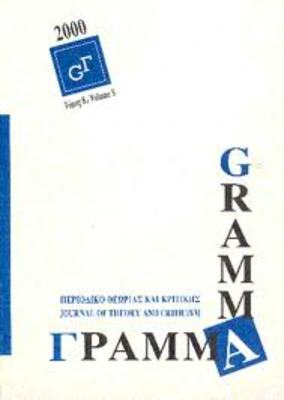The Theory of the Copy : Henry Fox Talbot and The Pencil of Nature
Part of : Γράμμα : περιοδικό θεωρίας και κριτικής ; Vol.21, 2013, pages 93-113
Issue:
Pages:
93-113
Author:
Abstract:
This paper explores how Henry Fox Talbot's enigmatic mid-nineteenthcentury "book" The Pencil of Nature staged a key moment in media history. By working through some of the key themes that framed Talbot's conception of the copying process, it is possible to examine a vital moment in the historical drama of mechanical reproduction. In this paper I argue that, departing from Walter Benjamin's formulation of the copy, Talbot's emotional investment in the copying process effectively imbricates the modern image in an affective field of historical memory, securing the meaning of the copy for futurity. The Pencil of Nature demonstrates in its relation to images, and to the copying process, a particular mode of collecting, constructing, cultivating, and transferring meaning. Reading The Pencil of Nature as a manifestation of lyrical, etymological, and antiquarian modes of nineteenth-century thought, this essay negotiates how Talbot nostalgically and sentimentally positions the reproducible modern image, prefiguring image production systems in modernity and postmodernity.
Subject:
Subject (LC):
References (1):
- Armstrong, Carol M. Scenes in a Library: Reading the Photograph in the Book, 1843-1875. Cambridge, Mass: MIT Press, 1998. Print.Barthes, Roland. Camera Lucida: Reflections on Photography. New York: HillandWang, 1981. Print.Benjamin, Walter. Illuminations. Ed. Hannah Arendt. Tran. Harry Zohn. New York: Schocken, 1968. Print.Buckland, Gail. Fox Talbot and the Invention of Photography. Boston: D.R. Godine, 1980. Print.Guillory J."Genesis of the Media Concept." Critical Inquiry 36.2 (2010): 321-62. Print.Hegel, Georg Wilhelm Friedrich, Bernard Bosanquet, and M. J. Inwood. Introductory Lectures on Aesthetics. London: Penguin Books, 2004. Print.Hofkosh, Sonia. "Early Photography's Late Romanticism." European Romantic Review 22:3 (2012): 293-304. PrintLassam, Robert E. Fox Talbot, Photographer. Tisbury Eng.: Compton Press, 1979. Print.Levine, Philippa. The Amateur and the Professional: Antiquarians, Historians, and Archaeologists in Victorian England, 1838-1886. Cambridge: Cambridge University Press, 1986. Print.Lloyd, Christopher. "Picture Hunting in Italy: Some Unpublished Letters (1824-1829)." Italian Studies 30:1 (1975): 42-68. Print.Maimon, Vered. "Displaced Origins': William Henry Fox Talbot's the Pencil of Nature." History of Photography 32.4 (2008): 293-314. Print.Maxwell, Richard. The Victorian Illustrated Book. Charlottesville: University Press of Virginia, 2002. Print.Pauli, Lori, and John P. McElhone. 19th-century British Photographs from the National Gallery of Canada. Ottawa: National Gallery of Canada, 2011 .Print."The Pencil of Nature". The Spectator 825 (1844): 14. The Spectator Archive. Web. 8 Aug. 2012.Schaaf, Larry J., and William H. F. Talbot. The Photographic Art of William Henry Fox Talbot. Princeton, N.J.: Princeton University Press, 2000. Print.Sontag, Susan. On Photography. New York: Farrar, Straus and Giroux, 1977. Print.Sussman, Herbert L. Victorians and the Machine: The Literary Response to Technology. Cambridge, Mass: Harvard University Press, 1968. Print.Talbot, William H. V.English Etymologies. London: J. Murray, 1847. The Internet Archive. Web. 6 Jan. 2012.—. The Pencil of Nature. London: Longman, Brown, Green, & Longmans,1844. The Internet Archive. Web. 6 Jan. 2012.Wordsworth, William and Samuel T. Coleridge. Lyrical Ballads 1798 and 1800. Ed. Dahlia Porter and Michael Gamer. Peterborough, Ontario: Broadview Press, 2008. Print.




